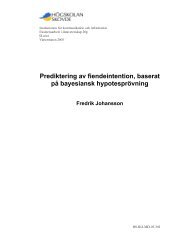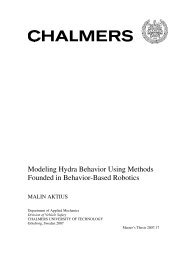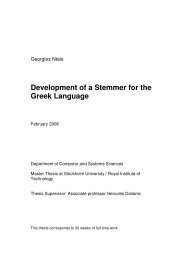Improved Pricing on the Stock Market with Trading Agents
Improved Pricing on the Stock Market with Trading Agents - SAIS
Improved Pricing on the Stock Market with Trading Agents - SAIS
Create successful ePaper yourself
Turn your PDF publications into a flip-book with our unique Google optimized e-Paper software.
ma<strong>the</strong>matical sign that all is not at random. This suggests that brokers follow herdinstincts [Haw, 2001]. This makes sense as brokers probably act <strong>on</strong> rumours thatspread across <strong>the</strong> markets. Similarly, big transacti<strong>on</strong>s <strong>on</strong> a stock market do create afollowing. Indeed, simulati<strong>on</strong>s <strong>with</strong> an artificial stock market, <strong>with</strong> computer agentsprogrammed to have ‘herd instincts’, have shown statistical similarities <strong>with</strong> <strong>the</strong>human counterpart [ibid.].There is also research that shows that <strong>the</strong> dynamics of share prices can bedescribed as a random walk [Osborne, 1977]. This c<strong>on</strong>tradicts what I have statedabove. Yet o<strong>the</strong>r reports show that <strong>the</strong>re are departures from a simple random walk instock prices. These anomalies are statistically significant, but practically <strong>the</strong>ir effectsare not large. From this follows that <strong>the</strong> effort I am making tests, in a way, how goodan approximati<strong>on</strong> <strong>the</strong> hypo<strong>the</strong>sis of stock prices as a random walk is, because it is in<strong>the</strong> departure from <strong>the</strong> random walk that profits can be found.With <strong>the</strong> above in mind, <strong>on</strong>e could envisi<strong>on</strong> scenarios where computer agentscould stabilize <strong>the</strong> stock market. Although <strong>the</strong> crash of <strong>the</strong> stock markets around <strong>the</strong>world in 1987 may have been induced or facilitated by computer aided investmentstrategies [Lux, 1995], computer agents could also, for example, have a stabilizingeffect if <strong>the</strong>y did not have <strong>the</strong> same herd instincts as human brokers. Humans andagents would interact in a complementary way that would make <strong>the</strong> stock market lessvolatile. In this way <strong>the</strong> danger of having to resort to more dramatic measures such ascircuit breakers, trade collars, etc. (measures to counteract extreme instability, forexample, a dramatic fall of an exchange) would be reduced. C<strong>on</strong>sidering <strong>the</strong>increasing volatility of <strong>the</strong> stock markets around <strong>the</strong> world in recent years this wouldbe a most welcome change for instituti<strong>on</strong>s running exchanges.1.2 ProblemAssignmentFor an instituti<strong>on</strong> running a marketplace high credibility of <strong>the</strong> marketplace is ofutmost importance. To achieve this end, <strong>the</strong>re are many different measures that comeinto c<strong>on</strong>siderati<strong>on</strong>. Am<strong>on</strong>g <strong>the</strong>se, measures that would decrease <strong>the</strong> transacti<strong>on</strong> costsare desirable [Wennerberg, 2001]. To decrease <strong>the</strong> transacti<strong>on</strong> costs, <strong>on</strong>e may, forexample, optimize <strong>the</strong> market structure, trading functi<strong>on</strong>ality, and fees. I have focused<strong>on</strong> issues c<strong>on</strong>cerning trading functi<strong>on</strong>ality.Specifically, <strong>the</strong> assignment given to me was to investigate future possibilities fortrading agents to be a part and functi<strong>on</strong>ality of <strong>the</strong> servers of a stock market. If <strong>the</strong>ylike, clients should be able to c<strong>on</strong>nect to a moderately customizable trading agent thattakes care of trading <strong>on</strong> <strong>the</strong>ir behalf according to <strong>the</strong>ir directi<strong>on</strong>s. These trading agentswould be running <strong>on</strong> a separate server <strong>with</strong> a direct link to <strong>the</strong> server that runs <strong>the</strong>matching service. In this way all <strong>the</strong> processes of c<strong>on</strong>tinuous evaluati<strong>on</strong> of c<strong>on</strong>diti<strong>on</strong>s,d<strong>on</strong>e by <strong>the</strong> agents, would not disturb <strong>the</strong> normal functi<strong>on</strong>ality of <strong>the</strong> matchingservice. The agents would have very fast and easy access to <strong>the</strong> matching service, as<strong>the</strong>y would not be hindered by slow c<strong>on</strong>necti<strong>on</strong>s <strong>on</strong> <strong>the</strong> Internet or heavy networkloads. Clients could place <strong>the</strong>ir orders <strong>with</strong> <strong>the</strong>se agents ra<strong>the</strong>r than placing <strong>the</strong>irorders, <strong>on</strong>e at a time, via a network. This would be particularly advantageous whenapproaching heavy load situati<strong>on</strong>s. With <strong>the</strong> right c<strong>on</strong>diti<strong>on</strong>s fulfilled, extreme levelsof messaging/network traffic could be reduced to levels at which measures such asthrottling (braking <strong>the</strong> matching service to avoid price update disseminati<strong>on</strong>c<strong>on</strong>gesti<strong>on</strong>) could be avoided. This, in turn, might increase <strong>the</strong> number of dealscompleted.2





